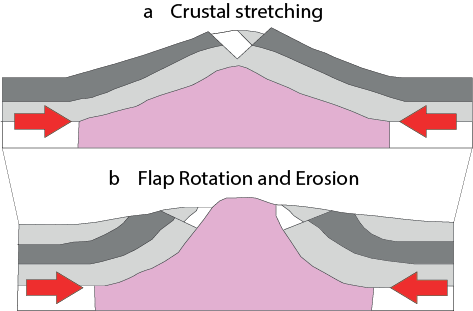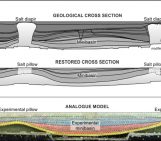
The TS Must-Read paper by Hudec and Jackson (2007) provides a combination of analogue models and natural cases to describe, in a review paper, salt flow mechanisms, diapir growth, and the ways these processes interact with regional deformation, in compression and extensional tectonics.

“Salt Dome” comic from xkcd (https://xkcd.com/2752/)
Salt is mechanically weak and can flow like a fluid under gravitation, displacement, and thermal loading. However, the strength of the overlying sediment is the first factor in controlling the salt body behavior: the higher the strength of the overburden, the more difficult the roof deformation. As a result, roofs of more than several hundred meters of thickness are unlikely to be deformed by salt without assistance from regional extension or shortening. In this sense, Hudec and Jackson (2007) pointed out that salt diapirs grow only if the overburden rock is removed or displaced, thus explaining why for most natural cases salt is combined with tectonic deformation.

Fig. 1 Diapir piercement during regional extension (credit: Riccardo Lanari modified from Hudec and Jackson 2007)
During extension (Fig. 1) the overburden can be stretched, deformed, lifted, rotated, eroded or shouldered aside as the diapir forcibly breaks through it by active diapirism. Models suggest that extension thins and fractures the overburden, favoring the salt to rise up the axis of the dismembering graben, thereby filling the space created in a so-called “reactive diapirism”, which stops whenever the tectonics ends (Fig. 1b). Reactive diapirism thins and weakens the salt’s roof up to the point where it can be uplifted and shouldered aside by forcible rise of the underlying diapir, becoming ‘active diapirism’ (Fig. 1c). Because active diapirism is controlled by gravitational forces acting on the salt, it continues even if regional extension stops (Vendeville and Jackson, 1992). Active diapirs typically break through their remaining roofs quickly and rise to the sediment surface, becoming passive diapirs (Fig. 1d).

Fig. 2 Diapir piercement during regional compression (credit: Riccardo Lanari modified from Hudec and Jackson 2007)
Conversely, during compression (Fig. 2), the salt’s overburden buckles and salt flows into the lower-pressure core of a rising anticline (Fig. 2b). Because salt structures are weaker than other parts of a basin, their roofs tend to shorten much more than adjacent areas. This amplifies pre-existing structures by arching their roofs in a circular process where the salt pierces the roof by some combination of crestal normal faulting, crestal erosion, and active diapirism (Fig. 2b). Buoyancy may have a role in this type of active diapirism, favoring the up flowing of the salt in a passive diapir style.
To conclude, Hudec and Jackson (2007) highlighted how salt layers form extremely efficient regional décollements that, in turn, can potentially influence the style of deformation. In this sense, they provide a beautiful review of how salt-deformation interacts with extension or compression in order to better unravel tectonics processes (e.g. Jahani et al., 2009; Quirk et al., 2012; Calvin et al., 2012).
Written by Riccardo Lanari and the TS must read team
References
Hudec, M. R., & Jackson, M. P. (2007). Terra infirma: Understanding salt tectonics. Earth-Science Reviews, 82(1-2), 1-28. https://doi.org/10.1016/j.earscirev.2007.01.001
Jahani, S., Callot, J. P., Letouzey, J., & Frizon de Lamotte, D. (2009). The eastern termination of the Zagros Fold‐and‐Thrust Belt, Iran: Structures, evolution, and relationships between salt plugs, folding, and faulting. Tectonics, 28(6).
Quirk, D. G., Schødt, N., Lassen, B., Ings, S. J., Hsu, D., Hirsch, K. K., & Von Nicolai, C. (2012). Salt tectonics on passive margins: examples from Santos, Campos and Kwanza basins. Geological Society, London, Special Publications, 363(1), 207-244.
Warren, J. K. (2010). Evaporites through time: Tectonic, climatic and eustatic controls in marine and nonmarine deposits. Earth-Science Reviews, 98(3-4), 217-268.
Vendeville, B. C., & Jackson, M. P. (1992). The rise of diapirs during thin-skinned extension. Marine and Petroleum Geology, 9(4), 331-354.




